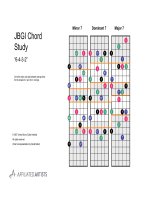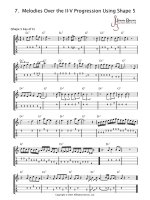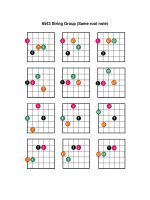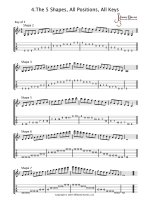04 4 using block annotated tủ tài liệu bách khoa
Bạn đang xem bản rút gọn của tài liệu. Xem và tải ngay bản đầy đủ của tài liệu tại đây (263.42 KB, 10 trang )
Online
Cryptography
Course
Dan
Boneh
Using
block
ciphers
Modes
of
opera6on:
many
6me
key
(CBC)
Example
applica6ons:
1.
File
systems:
Same
AES
key
used
to
encrypt
many
files.
2.
IPsec:
Same
AES
key
used
to
encrypt
many
packets.
Dan
Boneh
Construc6on
1:
CBC
with
random
IV
Let
(E,D)
be
a
PRP.
ECBC(k,m):
choose
random
IV∈X
and
do:
IV
IV
m[0]
m[1]
m[2]
m[3]
⊕
⊕
⊕
⊕
E(k,⋅)
E(k,⋅)
E(k,⋅)
E(k,⋅)
c[1]
c[2]
c[3]
c[0]
ciphertext
Dan
Boneh
Decryp6on
circuit
In
symbols:
c[0]
=
E(k,
IV⨁m[0]
)
⇒
m[0]
=
D(k,
c[0])
⨁
IV
⊕
m[0]
D(k,⋅)
c[2]
D(k,⋅)
c[3]
D(k,⋅)
⊕
D(k,⋅)
c[1]
⊕
c[0]
⊕
IV
m[1]
m[2]
m[3]
Dan
Boneh
CBC:
CPA
Analysis
CBC
Theorem:
For
any
L>0,
If
E
is
a
secure
PRP
over
(K,X)
then
ECBC
is
a
sem.
sec.
under
CPA
over
(K,
XL,
XL+1).
In
par6cular,
for
a
q-‐query
adversary
A
a]acking
ECBC
there
exists
a
PRP
adversary
B
s.t.:
AdvCPA
[A,
ECBC]
≤
2⋅AdvPRP[B,
E]
+
2
q2
L2
/
|X|
Note:
CBC
is
only
secure
as
long
as
q2L2
<<
|X|
Dan
Boneh
An
example
AdvCPA
[A,
ECBC]
≤
2⋅PRP
Adv[B,
E]
+
2
q2
L2
/
|X|
q
=
#
messages
encrypted
with
k
,
L
=
length
of
max
message
Suppose
we
want
AdvCPA
[A,
ECBC]
≤
1/232
⇐
q2
L2
/|X|
<
1/
232
• AES:
|X|
=
2128
⇒
q
L
<
248
So,
afer
248
AES
blocks,
must
change
key
• 3DES:
|X|
=
264
⇒
q
L
<
216
Dan
Boneh
Warning:
an
a]ack
on
CBC
with
rand.
IV
CBC
where
a]acker
can
predict
the
IV
is
not
CPA-‐secure
!!
Suppose
given
c
⟵
ECBC(k,m)
can
predict
IV
for
next
message
Chal.
k←K
0
∈
X
c1
←
[
IV1,
E(k,
0⨁IV1)
]
m0=IV⨁IV1
,
m1
≠
m0
c
←
[
IV,
E(k,
IV1)
]
or
c
←
[
IV,
E(k,
m1⨁IV)
]
Adv.
predict
IV
output
0
if
c[1]
=
c1[1]
Bug
in
SSL/TLS
1.0:
IV
for
record
#i
is
last
CT
block
of
record
#(i-‐1)
Dan
Boneh
Construc6on
1’:
nonce-‐based
CBC
• Cipher
block
chaining
with
unique
nonce:
key
=
(k,k1)
unique
nonce
means:
(key,
n)
pair
is
used
for
only
one
message
nonce
m[0]
IV
m[1]
m[2]
m[3]
⊕
⊕
⊕
⊕
E(k1,⋅)
E(k,⋅)
E(k,⋅)
E(k,⋅)
E(k,⋅)
nonce
c[0]
c[1]
c[2]
c[3]
ciphertext
included
only
if
unknown
to
decryptor
Dan
Boneh
An
example
Crypto
API
(OpenSSL)
void
AES_cbc_encrypt(
const
unsigned
char
*in,
unsigned
char
*out,
size_t
length,
const
AES_KEY
*key,
unsigned
char
*ivec,
⟵
user
supplies
IV
AES_ENCRYPT
or
AES_DECRYPT);
When
nonce
is
non
random
need
to
encrypt
it
before
use
Dan
Boneh
A
CBC
technicality:
padding
IV
m[0]
IVʹ′
m[1]
m[2]
m[3] ll pad
⊕
⊕
⊕
⊕
E(k1,⋅)
E(k,⋅)
E(k,⋅)
E(k,⋅)
E(k,⋅)
IV
c[0]
c[1]
c[2]
c[3]
TLS:
for
n>0,
n
byte
pad
is
n n n
⋯
n
if
no
pad
needed,
add
a
dummy
block
removed
during
decryp6on
Dan
Boneh
End
of
Segment
Dan
Boneh









